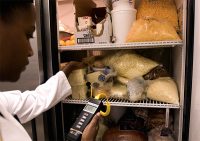To get to the restaurant table, food must travel great lengths to preserve that farm fresh quality and in many cases, IoT-enabled sensors are being used to do this. This is especially important as the World Health Organization estimates that one in 10 people fall ill every year from eating contaminated food.
When we think of our favorite dish, we often associate it with delicious flavors, pleasant scents and even memories of a night out with friends. What we likely don’t consider is technology, something that’s critical in ensuring the meal on our plate is safe to consume. Technology plays an essential role in guaranteeing that restaurants are serving fresh food to customers. From identifying operational deficiencies to protecting the overall brand of an organization, there are certain measures restaurants are taking—whether local or country-wide chains—to ensure food quality remains a top priority.
Restaurants are perhaps held to an even higher standard than your local supermarket when it comes to the quality of food on the table. Therefore, it’s imperative that perishables are cared for properly throughout the entirety of the food supply chain and that starts well before the food ever enters the restaurant’s front door. With long-range, low-power wireless IoT technology, farmers can get insights into a number of variables that may impact the growth of their crops. Armed with that knowledge, they can make real-time decisions to optimize crop growth and ultimately produce a greater yield. For example, farmers today can set up a series of sensors throughout their farm to measure real-time soil conditions, including humidity and pH levels. If they notice an especially high pH, for example, they can immediately remedy the situation and provide the crop with the proper nutrients or conditions it needs to grow.
For food safely to arrive at restaurants, it must be kept in a controlled environment during its journey from the farm or warehouse, and carefully monitored during that time. The temperature of refrigerated shipping units or storage facilities is an incredibly important factor, as bacteria growth can increase even by simply opening the refrigerator door or with a slight temperature shift, and employees are often tasked with managing this. With large facilities comes increased labor for employees, which can lead to inefficient temperature monitoring. To eliminate food waste and contamination, IoT sensors deployed throughout facilities can eliminate human error, and deliver more consistent monitoring, via real-time updates when temperatures enter unsafe territories.
Numerous international food handling and food safety laws have been implemented to reduce the risk of foodborne illness resulting from bacterial growth. A major component of most “farm-to-fork” regulations is the ability to track, report and maintain appropriate temperature conditions inside refrigeration and freezer units throughout the entire cold chain—including when the food finally makes it the restaurant.
This is a universal priority for restaurants around the world, including Hattie B’s Hot Chicken, a southern-style food chain, which started in Nashville and now has locations nationwide. To successfully do this, the restaurant turned to technology. They used a supplier of wireless connectivity solutions with integrated long range, low power technology for temperature monitoring sensors. The sensors, which are capable of penetrating stainless steel doors and concrete walls, can monitor temperatures in refrigerators and freezers. This is essential, as the technology eliminates possible human error in manually checking temps and other food safety procedures. In instances where refrigerator temperatures shift out of range, the technology remotely notifies restaurant managers in real-time, allowing them to act quickly, ensuring their perishables remain fresh and safe for customers at all times.
Food waste in restaurants is closely tied to food safety. In the United States alone, food waste is estimated to be between 30–40% of the food supply, according to the USDA. In the restaurant industry in particular, human error is one of the most notable reasons for food waste. To eliminate the human error when handling food and monitoring storage, an IoT solution provider for the industrial, smart city and smart energy segments, integrated long-range low power technology into smart refrigeration solutions for restaurant applications. This IoT solution is designed for humidity and temperature monitoring, delivering real-time updates to managers to ensure the shelf life of food is maximized and it remains safe to consume, ultimately leading to a decrease in food waste.
From farm to table, technology plays an essential role in ensuring restaurants are delivering the highest quality of fresh, safe food. It allows organizations to identify operational deficiencies and reduce overall food safety risk, which is imperative when maintaining a strong business in a competitive industry.






















